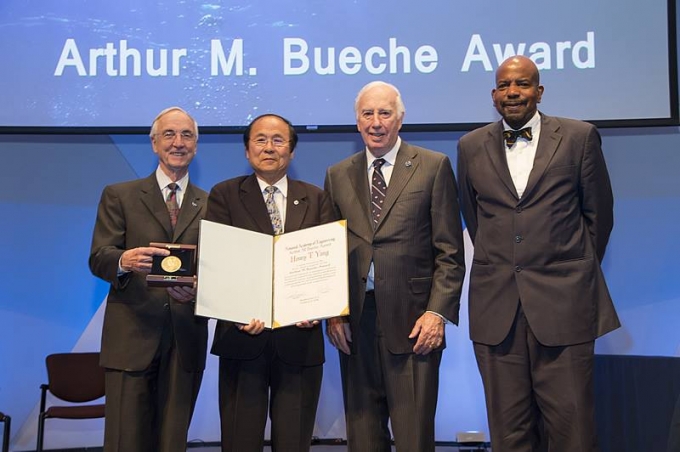At a ceremony held in Washington, DC, at the National Academy of Engineering's Annual Meeting in October, Chancellor Henry Yang was presented with the 2016 Arthur M. Bueche Award for seminal research in aerospace, civil, and mechanical engineering; superb contributions to national science and technology policy; and enhancements to international technological development and cooperation.
The award was presented to Yang by Gordon R. England (NAE Council Chair), Dr. C. D. Mote, Jr., (NAE President) and Dr. Cato T. Laurencin (2016 NAE Awards Committee Chair). In addition to more than two decades as Chancellor of UC Santa Barbara, Yang is an accomplished Professor of Mechanical Engineering with the College of Engineering.
In his acceptance speech, Yang recounted his early challenges as an aerospace engineer, his early career as Dean of Engineering at Purdue University, and his professional relationship with Neil Armstrong. Below are selections from his full speech:
"Over the past decades, we see that there were hundreds, or even thousands, of technological breakthroughs. And paving the way centuries earlier were our US patent laws of 1790, which, according to President Lincoln, “added the fuel of interest to the fire of genius, in the discovery and production of new and useful things.”
At the heart of each was an engineer. Theodore von Kármán said: “Scientists discover the world that exists; engineers create the world that never was.”
Royal Society President, Sir George Porter, once said, “There are only two kinds of science: applied and not-yet-applied.”
And this is our life’s work—not only making basic discoveries, but taking basic research and building once-inconceivable technologies."
Yang also relayed stories of recruiting (future) Nobel Prize-winning faculty at UCSB, which required a great deal of vision and decisive action.
"As chancellor of UC Santa Barbara for over two decades, there are many experiences and perspectives I could share. But allow me to focus on just one important aspect: the retention and recruitment of talents. I am honored and fortunate to serve on a campus where six colleagues have won Nobel Prizes during my tenure. I humbly offer, as examples, two of my engineering faculty colleagues, both proud NAE members.
Let’s go back 40 years to 1976, when Dr. Herbert Kroemer joined the faculty at UC Santa Barbara, before my time. Professor Kroemer decided to focus not on silicon semiconductors but rather gallium-nitride, a semiconductor material that was “notoriously difficult” to use. Decades later, he was awarded the Nobel Prize in Physics “for developing semiconductor heterostructures used in high-speed and opto-electronics.” His original vision was, and has been, upheld by our university with unwavering support. Supporting such vision and creating an intellectual environment are two of the most important ingredients for retention and recruitment.
Professor Kroemer’s work, first proposed in 1963, is the foundation of the blue laser and LED’s efficiency in converting electricity into light. He said in his Nobel acceptance speech that his original paper was rejected, ignored, refused – rejected by Applied Physics Letters; ignored once published in the Proceedings of the IEEE; and finally, he was refused resources to develop this new laser.
About 30 years after submitting that paper, while at a conference in Berlin in 1996, Professor Kroemer witnessed what he said was “the beginning of the end of the lightbulb” when a young engineer from Japan, Dr. Shuji Nakamura, demonstrated his bright blue laser. Kroemer later said, “We are not talking about doing things better, but about doing things we never could before.”
In the quest for talent, we went to Japan to recruit Dr. Nakamura to our faculty. As I’m sure you all agree, when it comes to the recruitment of talent, there are no borders. Just one year later, Professor Kroemer won his Nobel in 2000. Then we wondered, would Professor Nakamura ever get a Nobel for his invention?
As we know, it is not very common to receive a Nobel Prize for invention. Even Thomas Edison did not win a Nobel. I have heard that, for invention, one needs to demonstrate a richness of consequences. And what would that look like for the blue laser and LED? Professor Kroemer predicted, “Nakamura will win his Nobel when LEDs are sold in Costco.”
In 2013, when I saw the shelves of Costco stocked with LED lightbulbs, I knew the time had come. The following year, Professor Nakamura received his Nobel Prize in Physics: for an invention with a richness of consequences—for our field, for our economy, and for our world—through affordable, energy-efficient lighting.
This is our calling and contribution as engineers—to create endless innovations at the endless frontiers of science."

Dr. Henry T. Yang, Chancellor, University of California, Santa Barbara, was presented with the 2016 Arthur M. Bueche Award by Gordon R. England (NAE Council Chair), Dr. C. D. Mote, Jr., (NAE President) and Dr. Cato T. Laurencin (2016 NAE Awards Committee Chair) during the NAE Annual Meeting, October 9, 2016, in Washington, DC. Credit: National Academy of Engineering
